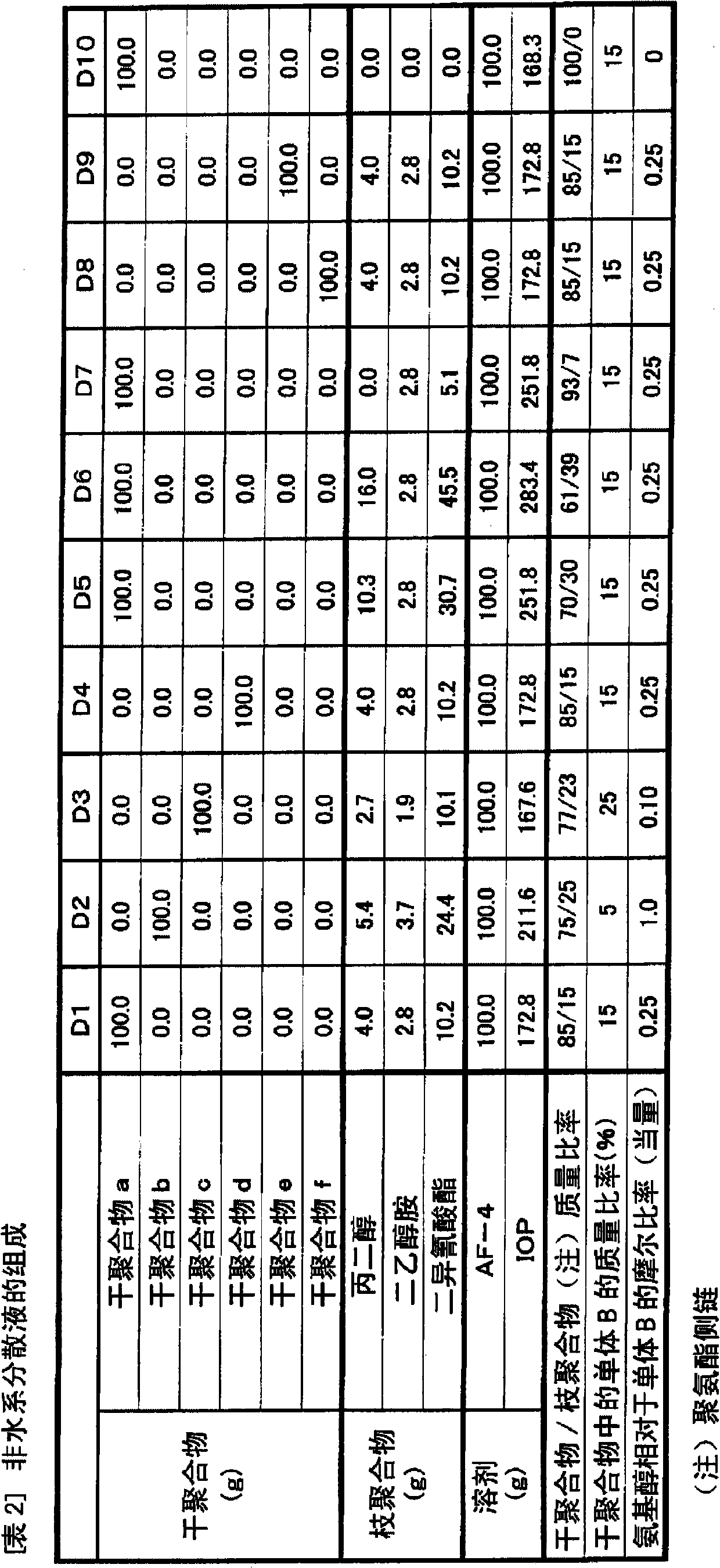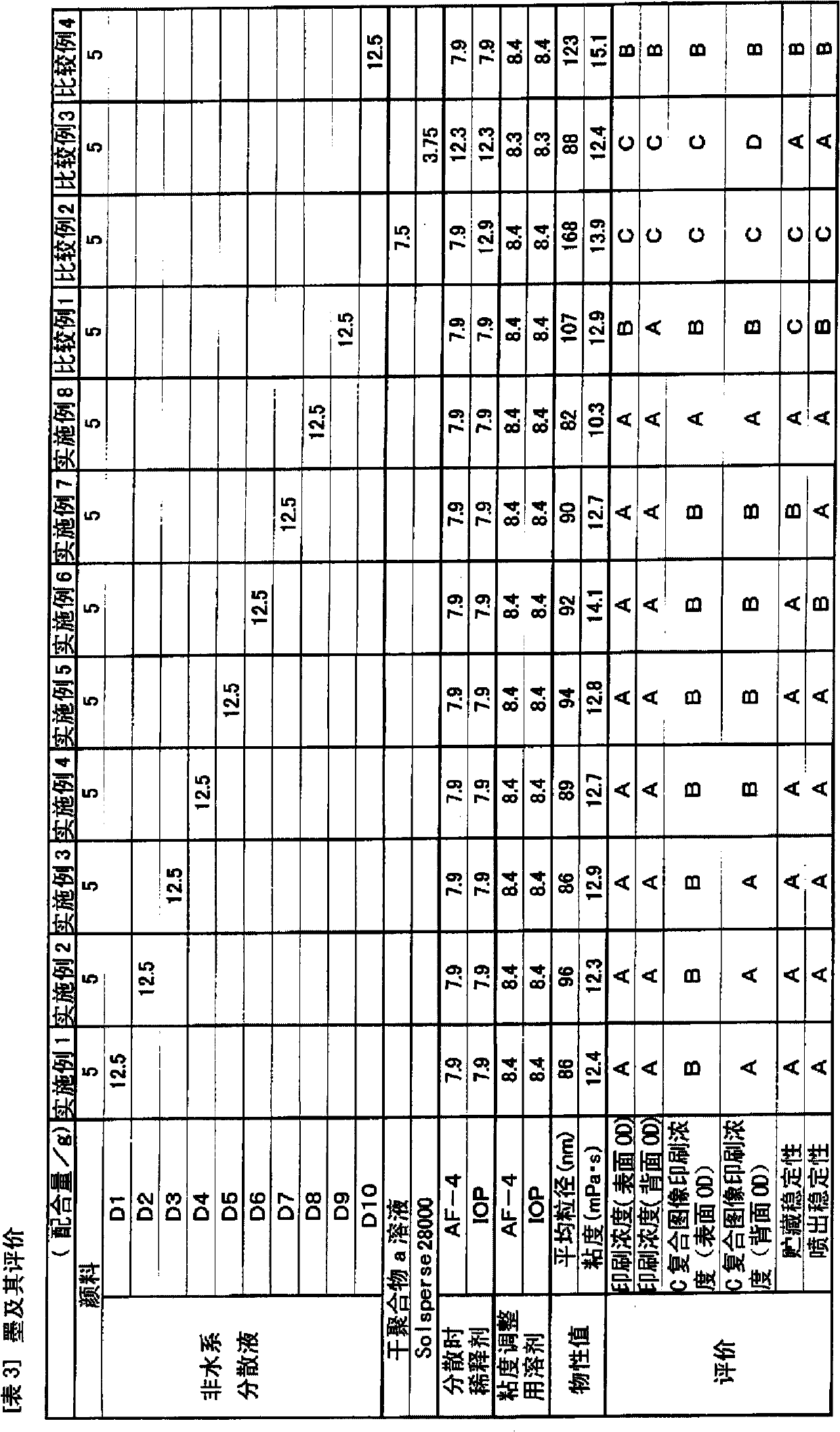Non-aqueous pigment ink
A non-aqueous, non-aqueous resin technology, applied in the direction of ink, copy/marking method, application, etc., can solve the problems of easy occurrence of print-through, lower printing density, etc., to reduce print-through, improve storage stability, and improve spray the effect of stability
- Summary
- Abstract
- Description
- Claims
- Application Information
AI Technical Summary
Problems solved by technology
Method used
Image
Examples
Embodiment 1
[0093] (1) Synthesis of copolymers (dry polymers a to f)
[0094] 75 g of AF-4 (a naphthene-based solvent; manufactured by Nippon Oil Corporation) was placed in a 300 ml four-neck flask, and the temperature was raised to 110° C. while blowing nitrogen gas and stirring. Then, the temperature was kept at 110° C., and 16.7 g of AF-4, 2 g of Perbutyl O (2-ethyl tert-butyl peroxyhexanoate; Japan Co., Ltd.) mixture. Then, the temperature was kept at 110° C., and 0.2 g of Perbutyl O were added after 1 hour and 2 hours each. Furthermore, aging was carried out at 110° C. for 1 hour and diluted with 10.6 g of AF-4 to obtain colorless and transparent dry polymer a to f solutions with a non-volatile content of 50%.
[0095] The mass average molecular weight (GPC method, standard polystyrene conversion) of each obtained dry polymer was 20,000 to 23,000.
[0096] [Table 1]
[0097]
[0098] Details of the monomers used are shown below.
[0099] Monomer (A): VMA (the carbon number of...
Embodiment 2~8、 comparative example 1~4
[0127] According to the formulation shown in Table 3, the inks of the respective examples and comparative examples were obtained in the same manner as in Example 1 above.
[0128] In Comparative Examples 2 and 3, a dry polymer a solution (50% solid content) and Solsperse 28000 (manufactured by The Lubrizol Corporation, 100% solid content) were used instead of the non-aqueous dispersion liquid, respectively.
[0129] [table 3]
[0130]
[0131] All of the obtained inks had a viscosity and a pigment particle diameter within an appropriate range for inkjet inks. The particle size of the ink was measured with a dynamic light scattering particle size distribution device LB-500 manufactured by Horiba Seisakusho. The viscosity of the ink is the viscosity when the shear stress is increased from 0 Pa to 10 Pa at a rate of 0.1 Pa / s at 23°C. The stress-controlled rheometer RS75 (cone angle 1°, diameter 60mm) manufactured by HAAKE Co., Ltd. To measure.
[0132]
[0133] Each ink w...
PUM
| Property | Measurement | Unit |
|---|---|---|
| particle size | aaaaa | aaaaa |
| diameter | aaaaa | aaaaa |
Abstract
Description
Claims
Application Information
 Login to View More
Login to View More - R&D
- Intellectual Property
- Life Sciences
- Materials
- Tech Scout
- Unparalleled Data Quality
- Higher Quality Content
- 60% Fewer Hallucinations
Browse by: Latest US Patents, China's latest patents, Technical Efficacy Thesaurus, Application Domain, Technology Topic, Popular Technical Reports.
© 2025 PatSnap. All rights reserved.Legal|Privacy policy|Modern Slavery Act Transparency Statement|Sitemap|About US| Contact US: help@patsnap.com



